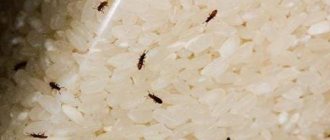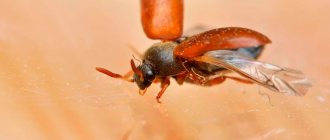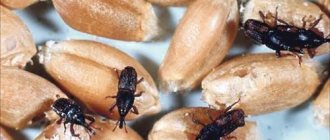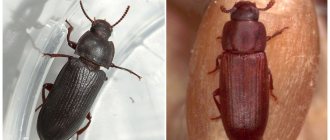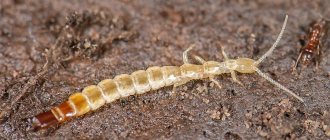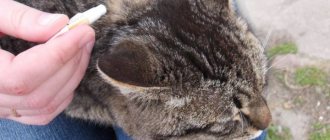Remember when you grew your first beans? Did you wrap the beans in a wet cloth, watch how the root hatched and the bean flaps turned into leaves, how the first real leaf appeared, how your vine began to grow, curl, and bloom brightly? And then you harvested the first harvest, carefully peeled the beans from the pods, and put them in storage. Spotty, clean, shiny, beautiful beans, carefully grown by your hands, were left to winter in the closet.
First bean harvest
Spring, you are getting ready to grow a new rich harvest, you open a bag of seeds, and there... Do you remember your feelings? Your beautiful beans are eaten away by round tunnels, swarming with beetles, and there is nothing but dust all around! Disgust, disappointment, anger! The harvest is irretrievably lost. How did it happen? What went wrong? Why are there bugs in the beans? Who is this bean beetle? Let's discuss and properly prepare for the next season.
There are bugs in the beans
Main pests of beans, prevention and control of them
Pests lie in wait for legumes at all stages of their life. The sprout fly feeds only on young sprouts and parasitizes on the roots of beans. Slightly grown stems and young leaves become prey for slugs. Aphids attack the adult leaves of the plant, sucking out all the juices from them. Mature pods with seeds are attacked by bean weevil. These are not the only, but the most common pests of beans. Let's take a closer look at them.
Bean grain
A heat-loving small beetle from the caryopsis family, only 2-5 mm in size, feeding mainly on mature beans. If you look at the insect under a magnifying glass, it seems quite cute: a small beige body completely covered with copper-colored hairs, short spotted wings, tenacious legs with sharp teeth. It does not tolerate cold at all, so it overwinters in granaries or other rooms with temperatures above +15°C. In winter, it feeds on beans or other grains. In the wild it produces 2-3 offspring per year; in storage or residential conditions it reproduces year-round. After overwintering, the beetle goes in search of food, flying up to 3 km a day in search of beans. Until the beans are ripe, they are content with their leaves and flower pollen, but can live completely without food for up to three months.
Bean grain
The bean weevil causes colossal harm to plants, as it damages not only the grains, but the flowers and leaves of legumes, preventing them from fully developing and bearing fruit. If beans are infested with bugs, the crop can be considered completely lost. The female gnaws through the pod and lays up to 20 eggs, only 20 microns in size, under the skin of the bean, from each of which mobile larvae hatch after 2 weeks. They feed on grain tissues and move inside it using legs, thus forming tunnels. After another 3 weeks, the larva pupates, later turning into a young beetle. The beetle emerges from the grain, gnawing a neat round hole in it. The cycle repeats...
So, you discovered that there are bugs in your beans. What to do?
If a pest is found in a summer cottage, it is necessary to remove all weeds and spray the insecticide Metafox or Decis on the crops. After 10 days, repeat the treatment.
If you have already found it at home, you need to carefully examine each bean and ruthlessly throw away all damaged and questionable specimens. Dry the remaining beans in the oven and store them according to the rules, which we will discuss in more detail below.
Sprout fly
A small midge, no larger than a bean grain (on average 3-6 mm), parasitizes legume seedlings. Outwardly, it is no different from the houseflies we are familiar with. The hairy body consists of a small head with huge eyes, a chest and a gray abdomen. The forehead is decorated with small mustaches. These are the insect's olfactory organs.
If the sprout fly does not find beans, it is content with other garden plants. Midges appear in April-May and find a mate of the opposite sex. After successful fertilization, many small white eggs are laid in the ground. They die in dry soil, but if you plant the seeds, water and fertilize the soil, the eggs turn into larvae in 9 days. The larvae penetrate the germinating beans and damage the root and stem. It is unlikely that the plant will be saved.
Sprout fly
Flies are extremely fertile, and their larvae are voracious. A newborn transparent larva, only 1-2 mm long, after 20-30 days of active growth and feeding on the tissues of germinating beans, reaches a height of 7 mm, thickens and turns into a mobile pupa. When the temperature drops, the pupa moves into the soil and buries itself at a depth of 10 cm, surviving the cold in this state. When spring comes, it turns into a midge, and the cycle repeats. In one summer, 3 generations of midges fly out of the ground: in April-May, June, July.
You can destroy the sprout fly with insecticides containing phosphorus, or simply plant already grown seedlings in the ground, to which the midge will not cause significant damage.
Sprout fly larva damaged beans
Slugs
A slug is a small, wet, soft-bodied pest that looks like a snail without a “house” on its back. Reaches a size of 5 mm, feeds on all parts of the plant. Since slugs are moisture-loving, in dry weather they take refuge under leaves, boards, cellophane and other objects that retain moisture. The appearance of a slug leads to the death or weakening of the entire vine, since it is omnivorous: it eats leaves, stems, flowers, and young pods with its teeth - using graters.
Slugs
To get rid of slugs, you need to properly dry the soil and remove all natural hiding places for parasites. In low humidity conditions, slugs die within a few days. To combat them, you can cover the soil with dried nettle, which will repel pests.
You can also use the original folk method of luring slugs with beer. To do this, you need to bury a small plastic bottle half filled with beer in the ground near the bean plantings. The neck of the bottle should not rise too much above the soil surface; the lid has been removed. Attracted by the smell of beer, the slugs will move into the bottle, but will not be able to get out. After a few days of repeating this procedure, all the slugs will be trapped.
Aphid
Aphids are such common insects that they are familiar even to people far from country life. Among the one and a half thousand varieties of this pest, the most dangerous for legumes is the melon aphid. Small parasites can appear seemingly from nowhere; the female molester is very active due to the presence of wings. Aphid colonies can start on one plant and quickly spread throughout the entire area of the garden. The insect uses a sharp proboscis to make a puncture in the tissue of a leaf or stem and sucks out all the liquid contents. The leaf curls and dries.
melon aphid
To get rid of aphids, you need to treat the plants with a soap solution or a solution of ash, which is diluted in a proportion of 2 cups per bucket of water.
Diseases
In addition to pests, beans can also be destroyed by diseases. There are several reasons why beans turn black. To understand this, you need to know the main features of the diseases of this culture.
Powdery mildew
This disease is characterized by the appearance of a whitish coating on the leaves and stems of the plant. Gradually, the affected areas turn yellow.
Anthracnose
This pathology is distinguished by the fact that brown spots form on leaves, fruits, and stems. The leaves dry out and burgundy sores form on the fruits.
White rot
Affects stems and fruits. The infected areas become soft and gradually turn white. Rotting leads to the death of the planting.
Root rot
A whitish-pinkish coating appears on the roots. The beans are stunted and gradually die.
Bacterial spot
Under the influence of this pathology, the plant turns black. First, spots appear on it, which merge together over time. Gradually the planting fades.
Bean mosaic
With this disease, the leaves become variegated in color. Gradually, the leaves wrinkle and the plant withers.
Preparing beans for storage
So, we have defeated all garden pests, collected a good harvest of beans, and are preparing to store them. First of all, the pods need to be dried. You can leave them in the sun if the climate allows, or spread them out on a clean cloth at home. Once dry, they will begin to open on their own. This is the optimal time for peeling.
The extracted beans must be carefully inspected and only absolutely healthy, undamaged specimens must be selected for storage. If you do not plan to use the seeds for planting, they must be heated in the oven for five minutes at a temperature of 90°C. This procedure will make your beans dry and unable to germinate. There is another way to get rid of bugs in beans - freezing for 72 hours at minus 18°C. After such a procedure, pests will have nothing to start from!
Drying the bean pods
What damage do beetles cause?
The beetles do not attack people or bite, but they cause significant harm to humans. Infection of plants leads to a decrease in yield. The bean weevil begins to harm plants even at the stage of their growth, damaging early crops. There have been cases where the bean yield was reduced by 70%. In addition to beans, insects are not averse to eating chickpeas, soybeans, and peas. The photo shows beans damaged by beetles.
Harm from grain
The larvae eat away nutrients from the grains and fill them with their waste products, which makes the beans unsuitable for sowing and consumption. The entry of infected beans into storage jeopardizes the safety of the entire crop.
Saving bean seeds at home
If there is no pantry or cellar, you can store the harvest in a city apartment. The optimal place would be a refrigerator with a temperature of plus 7°C or an insulated loggia in winter. Beans should not be kept in the cold for a long time; they may lose moisture and some of their taste. When stored at room temperature, the seeds may germinate if they have not been previously frozen or heated in the oven.
The grains selected for storage can be placed in glass jars and then closed with airtight lids. Lids should not allow air to pass through. You can use fabric bags that have been previously washed, soaked in saline solution, and dried with an iron.
Storing beans in a jar
Store beans in a bag
Slugs
The pest is polyphagous, its harmfulness is great - it “mows down everything.”
Flattened, slippery, light gray. Despite its “softness”, it has hard teeth - a grater with tens of thousands of teeth.
It takes a long time for a slug to develop and grow: a year to a year and a half. The life of slugs ends with the laying of eggs.
An interesting fact from the “who would have thought” category: slugs have a mandatory element - mating games and dancing.
Newborn slugs eat egg shells and frozen eggs with embryos. They grow very quickly. After switching to vegetarianism, they grow more slowly.
They feed on greens and fruits during all stages of growth. Even if he doesn’t eat everything, he “takes a bite,” and damaged plants or their fruits are quickly colonized by pathogenic microflora, rot, and become sick.
In the fight against slugs, their need for high humidity is taken into account. Up to one hundred percent. Minimum – 90%.
If you remove all kinds of pest shelters from the site - boards, pieces of film or fabric, and dry the soil until the plants slightly wilt, there will be a massive death of slugs.
The beans will withstand temporary drought, the main thing is to choose the phase.
If it is not yet filling or blooming, it will not harm the culture at all. And the slug is just active in delicate greenery.
Without enough moisture, it is doomed. You can leave the listed shelters for the pest; it will gather under them.
Use it as a trap and remove it later.
What to do if beans have bugs
If there are bugs in the beans, it is better to throw them all away. There is no good reason to use kernel-damaged beans. It is not suitable for planting, since it is impossible to accurately determine the presence or absence of pests in apparently undamaged grains. If you really want to plant damaged seeds, you will get weak and diseased seedlings that will not give you a good harvest. In addition, create conditions for the parasite to reproduce in your area.
Bugs in a can of beans
If there are only a few noticeable insects, and you really want to save at least part of the harvest for soup, you can sort through all the beans, examine them under a magnifying glass, and throw out any that are suspicious or obviously damaged. Freeze the remaining ones at minus 18-20°C for three days or heat them in the oven at +90-100°C , then store them using the technology described above.
Bean grain
“Name” bean pest. The small, harmful beetle is capable of destroying a crop completely.
Moreover, it works more – during storage. People will collect the harvest, dry it as it should be, package it in jars and on tables, where it is dark, for storage.
They take it out in the winter, deciding to try borscht with beans or some other dish. And in the jar there is no longer whole grain, each seed is a through sieve.
It was she who worked - the bean weevil. Although the beetle of the caryopsis family is polyphagous (it can also feed on other crops), it will definitely not pass by beans.
The black, small (up to half a centimeter) bug is close to beans in its demands on conditions.
It can develop at 13°, or better yet, higher. Therefore, he is active when his favorite crop begins to grow.
Even the egg-laying of the grain is extended for a long time: beans ripen unevenly. And the female is looking for beans and lays eggs on them.
The weevil needs beans - ripening so that the larvae can feed on ripe grain.
The bean weevil tries to lay eggs in the cracks of cracking beans. If he doesn’t find any, he gnaws out a hole in the back seam connecting the flaps.
One miniature female will leave fifty eggs there. Record-breakers have been spotted saving four times as much.
It is not difficult to imagine the degree of harmfulness of the beetle. More than fifty larvae sometimes feed on one grain at once.
In three weeks they eat up the entire seed. They pupate there, and a week later the beetles emerge, leaving a holey shell of the seed.
The insect is nimble: it runs and flies quickly. It also spreads quickly.
In the southern regions, the pest manages to produce brood four times in field conditions. It parasitizes in storage all year round.
If it is warmer than 10°C, then it breeds – constantly, as long as there is food. Can destroy all bean supplies.
If it is colder, it does not develop. But it doesn’t always die.
The larvae in the seeds can withstand zero temperatures for a month. Even minus four can be tolerated for half a month.
To ensure the destruction of the parasite inside the seeds, you need to freeze the grain for a day at –12°.
At this, or slightly lower, temperature, the adult beetles that have already emerged from the grains will die in the same amount of time.
Why do bugs appear and how to defeat them?
In nature, there is no miraculous phenomenon of insects out of nowhere. Pests must come from somewhere, so your case is no exception. There are two possible options:
- or the eggs of the beetles were originally laid in some beans, and became active during storage
- or you bought and brought home other legumes affected by the weevil.
To prevent this from happening, follow these simple tips:
- carefully inspect all beans being stored
- throw away any damaged or questionable copies
- When growing, use insecticides promptly. It’s easier to kill a pest at your dacha than to select one grain at a time at home
- Before storing, heat the legumes (freezing or heating in the oven)
- do not store beans in a warm place
- Place sharp-smelling plants next to the legumes - dill seeds or garlic
- Place the beans in different jars and close the lids tightly.
- Periodically inspect your supplies to notice the first signs of pests. Bugs will definitely show themselves in the beans (we have already described how to get rid of them above).
How not to lose your bean harvest
Protection measures
To protect plants from these diseases, it is necessary to get rid of pests, which often become their carriers. You should also provide optimal growth conditions for plantings and maintain humidity at the required level.
Preventive
If a summer resident is afraid that the beans will be affected by pests, he should prevent their occurrence. Most often, it is enough to use folk remedies that recommend covering the soil around the plants with dried nettles. You can also water the plantings with garlic broth, which will also repel pests.
Active
During the growth of the crop, the gardener is obliged to monitor the timeliness of development and the condition of the legume plant . This is necessary to identify the presence of a pest or disease at an early stage. Timely treatment will save not only the plant, but also the harvest.
melon aphid
There are many varieties of aphids. It’s bad for crops that aphids are not picky.
They called her a melon grower, she will not strictly specialize in melons, and along the way she will find a lot of tasty things for herself nearby.
The melon bean aphid loves melon no less than melon. Just because an aphid sticks while feeding does not mean that it is clumsy.
Aphids are not tied to their feeding place; they are very mobile. Even in the larval stage.
And the adult flies; the female settlers (that’s what they are called) grow wings.
They look for new feeding areas and lay eggs there. A bean plantation can quickly become overrun by such harmful travelers.
And the development cycle of aphids is short, leaving behind several generations.
The aphid is only soft in appearance; it has a hard piercing-sucking apparatus, a kind of “syringe”. Pierces tissues and sucks out nutritional contents.
There are always a lot of aphids, they quickly oppress the beans: the leaves curl and wither. Shoots and buds are deformed.
The plant may die. If it survives, it will not grow, the fruits will be frail or will not ripen at all.
Aphids also spread diseases.
They fight with agricultural technology - fragrant umbellifers are sown nearby. Aphids are not afraid of smell, but the scent attracts the natural enemies of aphids that feed on them: hoverflies.
Just less poisons so as not to kill beneficial insects (entomophages).
Good care is additional insurance against aphids for beans. Strong plants are resistant not only to diseases.
Pests also attack the weak.
An ash-soap solution is effective against any aphids. No special dosage, a handful - two ash per bucket.
Place in a small container of soap (laundry soap), dilute with warm water. It’s easier this way – dissolve the soap in a small volume and in almost hot water.
Combine the solutions and mix. Let it sit overnight, and if it’s urgent, you can do it right away: strain and spray on the “invader.”
Sprayers with adjustable spray direction are good: the aphids sit on the bottom plate, from there you need to treat the leaf to be sure.
An emulsion of green soap, diluted according to the instructions, will also help.
Dodder
There is also such an attack on garden and any other plants, even weeds. But legumes are her special passion; she never passes them by.
It seems difficult to classify dodder as a disease; it is closer to pests, but it cannot be called a pest either.
Plant parasite. This is the “signature tag” of the dodder. Due to her omnivorous nature, she attacks everything she can reach.
And it can stretch - the stems are thin, quickly growing, braiding in a spiral around the attacked plant.
These threads are less than half a millimeter thick. There are so many of them that they can braid the entire plant with their webs and spread even on the soil around them.
Dodder especially likes young, juicy, uncoarsened stems and leaves of garden crops.
Beans suffer from this parasite no less than others. Even more like all legumes, including alfalfa.
The weed is quarantine, but it crosses quarantine posts with ease, it is very common.
Dodder on almost orange thin stems has many suckers. These are root substitutes.
By sucking, the dodder does not work to obtain food, like other plants. She simply “drinks” it, obtained by others, from their stems, where the suckers stick.
The plant on which the dodder has settled is depleted, not receiving the nutrition stolen by the uninvited lodger. It gets sick, withers, dies.
The dodder grows quickly, its leaves are not visible, they are so small, almost microscopic scales on the branches of the stem and inflorescences.
Dodder flowers are small – 2 mm, but numerous. They are located tightly, like balls.
In these balls (pods) a huge number of almost dust-like seeds ripen. When they are ripe, the dodder no longer draws juice if the bean plant is still alive.
She has enough reserves accumulated in the stem.
Dodder formerly had its own family: Cuseutaceae. This means dodder.
Now scientists have decided that it is closer to the bindweed (it climbs). When the beans curl along the support, we rejoice.
But when the dodder hits the beans, it’s a disaster. Fighting it is not an easy task. The parasite reproduces not only by seeds.
The slightest fragment of a stem can attach itself to someone else’s and grow into a full-fledged parasitic plant.
And the seeds can germinate even after 10 years.
If you notice a dodder in your garden, try to get rid of it immediately. An affected bean plant is doomed.
Either it will die from the dodder and become its breeding ground, or the owner needs to remove it. Uprooted and burned.
It is useless to pick the dodder; an unnoticeable fragment will remain somewhere and will bring the fight to naught.
And the area of the soil where the dodder was on the plants is subjected to chemical treatment. We need herbicides.
You can treat the soil without poisons, ammonium nitrate, or a strong solution (20%), but you also need to cover the adjacent land.
In production, they “burn out” with saltpeter or pesticides plus a one and a half meter radius around the hearth. At the dacha it is more difficult.
But it’s easier not to miss the beginning. Then there will be no large foci of the parasite.
Agrotechnical measures – distance of legumes in crop rotation. Beans especially need to be protected from alfalfa.
Dodder is a frequent guest there; its seeds are mixed with alfalfa, and it is not easy to separate them.
Beans are not a particularly demanding plant in itself.
And it will grow wherever you want (though with different returns), and will tolerate a short delay in watering. It can do without fertilizing.
But the plant cannot do without your help, protection from aggressively besieging problems in the form of macro and microorganisms.
Timely assistance will be as useful as a spoon for dinner. Then the beans will come in handy for dinner in due time - for you.
Pay attention to her and make each other happy all year round.
See you soon, dear readers!
More humane ways for pensioners
So, how to get bugs out of cereals in the kitchen? There is nothing better than good old Dichlorvos.
The disgusting thing is, of course, rare, but it kills bugs on the spot. But before you treat the surfaces, find a place where you can then sit for at least half a day so that it can air out.
The procedure in this case is as follows:
- 1. Go through everything you can and take it outside (or another room)
- 2. Wipe cabinets, floors, baseboards with a damp cloth
- 3. Wash dishes and jars for cereals and pour boiling water over them (to kill the larvae)
- 4. Treat everything with Dichlorvos (necessarily wearing a mask and glasses) and retreat to visit someone
We do not advise you to call all sorts of companies that guarantee disinfection. They haven’t invented anything new, but it costs a lot of money.
No, if you have extra funds, then you can call so as not to breathe in the chemicals yourself. But, if we talk about efficiency, then there is no difference: you carry out the treatment yourself or pay people, no matter what they say, that eradicating it at home is unrealistic.
Here we are not talking about humanity towards bugs, but about humanity towards provisions, and therefore towards pensioners. Still, if you don’t have enough money, throwing away the cereal is simply the height of madness.
Therefore, you can use this method of struggle:
- Step 1. Sift the cereal through a fine sieve and sort thoroughly.
- Step 2. Then bake it in the oven or put the bags in the freezer for 3-4 days.
- Step 3: Try to use this grain as quickly as possible.
- Step 4. Still treat the cabinets, floor and other surfaces. If you can’t use chemicals, then at least wipe it with vinegar, pour boiling water over the cracks, or you can use laundry soap (rub it and make a soap solution). You can also make a solution of boric acid.
- Step 5. Be sure to wash the dishes, as there may be larvae there.
After you put the grains back in the box, you can place “traps” there. Pour sunflower oil into the caps and the remaining bugs will certainly taste this treat. And they will drown in it, and you will simply fly out this oil and that’s it.
Then, you can place bay leaves and garlic in the cabinets. We don’t guarantee that this is very effective and will help remove the bugs forever, but it calms the soul.
Where to store legumes - jars, bags or boxes?
The main storage containers are glass containers and bags made of natural fabric. Each method has its own characteristics.
Read more ► How to keep Jerusalem artichoke fresh all winter at home
Jar
Saving in glass containers is one of the most effective ways to avoid bugs. Before placing the fruits, about 4 cm of ash is poured into the bottom of the container.
The containers are sealed with metal and glass lids. A polyethylene lid is not suitable for these purposes, as it allows air to pass through.
The disadvantage of this method is that the legumes lose their ability to germinate.
The reason is that when the product is sealed so tightly, there is a lack of air not only for the growth of bugs, but also for normal respiration of the fruit.
The main storage containers are glass containers
The method is suitable if the beans will be used for cooking.
Bag or box
Linen bags and wooden boxes have their advantages. The fact is that such containers allow supplies to breathe. Before planting, the crop should be soaked for 30 minutes in salted water and dried well.
To prevent the appearance of bugs, dill seeds (20 g per 1 kg of legumes) and cut garlic cloves (4 pieces per 1 kg of product) are placed at the bottom of the bags and boxes.
The bags should be placed in a dry room out of direct sunlight. For this purpose, a kitchen cabinet with sealed opaque doors, which is located away from heating appliances, stoves, and ovens, is successfully used.
2 Available control methods: frying, freezing, soaking
Considering that bugs infect food, it is impossible to use insecticides and toxic substances (turpentine, vinegar, etc.). Such products can indeed destroy insects, but during processing, all cereals and flour will receive a dose of poison. As a result, it will be impossible to use them. Contaminated products are simply thrown away. This should be done if small insects are found in a bag of cereals/flour in large quantities, their metabolic products, cobwebs, spoiled grains with a damaged shell are visible.
If the groceries are not too spoiled, you can heat them:
